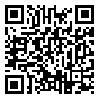دوره 10، شماره 1 - ( 12-1400 )
جلد 10 شماره 1 صفحات 9-1 |
برگشت به فهرست نسخه ها
Download citation:
BibTeX | RIS | EndNote | Medlars | ProCite | Reference Manager | RefWorks
Send citation to:



BibTeX | RIS | EndNote | Medlars | ProCite | Reference Manager | RefWorks
Send citation to:
Torkian S, Malek Mohammadi N, Mohammadizadeh M, Shahesmaeili A. Virtual Social Networks Addiction and High-Risk Group among Health Science Students in Iran: A Latent Class Analysis. Iran J Health Sci 2022; 10 (1) :1-9
URL: http://jhs.mazums.ac.ir/article-1-773-fa.html
URL: http://jhs.mazums.ac.ir/article-1-773-fa.html
ترکیان سمانه. Virtual Social Networks Addiction and High-Risk Group among Health Science Students in Iran: A Latent Class Analysis. علوم بهداشتی ایران. 1400; 10 (1) :1-9
چکیده: (3360 مشاهده)
Background and purpose: Virtual social networks (VSNs) are among the most popular communication paths that have become an integral part of most people's lives, including students. This study aimed to investigate the prevalence of VSNs addiction and their related factors, and identify the patterns of addictive-related factors among the students in Kerman, Iran in 2019.
Materials and Methods: This cross-sectional study was conducted on 400 students from Kerman University of Medical Sciences. The study instrument was a standardized questionnaire. Descriptive analysis, logistic regression models, and latent class analysis were used to analyze the data. The data were analyzed using SPSS26, Stata12 and WinLTA (v. 3.1) software.
Results: 50% of the participants were male, staying in dormitory. The number of individuals in the levels of education in the four groups was equal. Around 0.5% of the students were addicted and 36.5% were at the risk of addiction to VSNs. The most commonly used VSNs was the Telegram (76.8%), and most students (28.8%) spent between 2-3 hours a day on VSNs. In the multivariate model, using 1-2 hours (AOR = 3.33, 95% CI: 1.07 - 10.19), 2-3 hours (AOR = 7.33, 95% CI: 2.50 - 21.52) and more than 3 hours a day (AOR = 18.54, 95% CI: 6.05 - 56.8) of VSNs were associated with an increased odds of being at the risk of VSNs addiction. The Latent Class Analysis showed that high-risk addictive factors including using Telegram for entertainment, providing accommodation in the dormitory, and having a graduate degree significantly influenced the classification.
Conclusion: More than one-third of Kerman college students were found to be at the risk of VSNs addiction. Providing appropriate interventions including alternative activities as well as raising knowledge especially for undergraduate students is urgently needed.
Materials and Methods: This cross-sectional study was conducted on 400 students from Kerman University of Medical Sciences. The study instrument was a standardized questionnaire. Descriptive analysis, logistic regression models, and latent class analysis were used to analyze the data. The data were analyzed using SPSS26, Stata12 and WinLTA (v. 3.1) software.
Results: 50% of the participants were male, staying in dormitory. The number of individuals in the levels of education in the four groups was equal. Around 0.5% of the students were addicted and 36.5% were at the risk of addiction to VSNs. The most commonly used VSNs was the Telegram (76.8%), and most students (28.8%) spent between 2-3 hours a day on VSNs. In the multivariate model, using 1-2 hours (AOR = 3.33, 95% CI: 1.07 - 10.19), 2-3 hours (AOR = 7.33, 95% CI: 2.50 - 21.52) and more than 3 hours a day (AOR = 18.54, 95% CI: 6.05 - 56.8) of VSNs were associated with an increased odds of being at the risk of VSNs addiction. The Latent Class Analysis showed that high-risk addictive factors including using Telegram for entertainment, providing accommodation in the dormitory, and having a graduate degree significantly influenced the classification.
Conclusion: More than one-third of Kerman college students were found to be at the risk of VSNs addiction. Providing appropriate interventions including alternative activities as well as raising knowledge especially for undergraduate students is urgently needed.
نوع مطالعه: پژوهشي |
موضوع مقاله:
اپيدميولوژي
| بازنشر اطلاعات | |
 |
این مقاله تحت شرایط Creative Commons Attribution-NonCommercial 4.0 International License قابل بازنشر است. |








